Geometry | Maths - Parts of a Circle | 9th Maths : UNIT 4 : Geometry
Chapter: 9th Maths : UNIT 4 : Geometry
Parts of a Circle
Parts of a Circle
Circles are
geometric shapes you can see all around you. The significance of the concept of
a circle can be well understood from the fact that the wheel is one of the ground-breaking
inventions in the history of mankind.
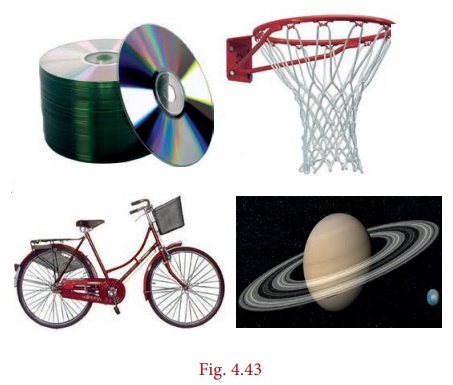
A circle, you can describe, is the set of all points
in a plane at a constant distance from a fixed point. The fixed point is the centre of the circle; the constant distance corresponds
to a radius of the circle.
A line that
cuts the circle in two points is called a secant
of the circle.
A line segment
whose end points lie on the circle is called a chord
of the circle.
Note
A circle notably differs from a polygon. A polygon (for example,
a quadrilateral) has edges and corners while, a circle is a ‘smooth’ curve.

A chord of
a circle that has the centre is called a diameter
of the circle. The circumference of a circle is its boundary. (We use the term perimeter in the
case of polygons).
In Fig.4.44,
we see that all the line segments meet at two points on the circle.
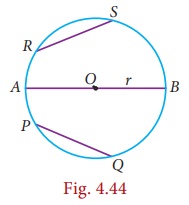
These line segments are called the chords of the circle. So, a line segment joining any two points on the circle is called a chord of the circle. In this figure AB, PQ and RS are the chords of the circle.
Now place
four points P, R, Q and S on the same circle (Fig.4.45),
then PRQ and QSP are the continuous parts (sections) of the circle.
These parts (sections) are to be denoted by  and
and ![]() or simply by
or simply by ![]() and
and ![]() .
.
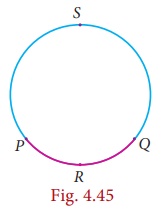
This continuous
part of a circle is called an arc of the circle. Usually the arcs are denoted in
anti-clockwise direction.
Now consider
the points P and Q in the circle (Fig.4.45). It divides the whole
circle into two parts. One is longer and another is shorter. The longer one is called
major arc ![]() and shorter one is called minor arc
and shorter one is called minor arc ![]() .
.
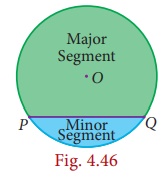
Now in (Fig.4.46),
consider the region which is surrounded by the chord PQ and major arc ![]() .
This is called the major segment of the circle. In the same way, the segment containing
the minor arc and the same chord is called the minor segment.
.
This is called the major segment of the circle. In the same way, the segment containing
the minor arc and the same chord is called the minor segment.
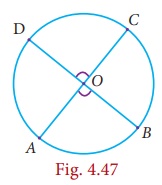
In (Fig.4.47), if two arcs ![]() and
and ![]() of a circle subtend the same angle at the centre, they are said to be congruent
arcs and we write,
of a circle subtend the same angle at the centre, they are said to be congruent
arcs and we write,

implies ∠AOB = ∠COD
Note
A diameter of a circle is:
• the line segment which
bisects the circle.
• the largest chord of a
circle.
• a line of symmetry for
the circle.
• twice in length of a radius
in a circle.
Now, let
us observe (Fig.4.48). Is there any special name for the region surrounded by two
radii and arc? Yes, its name is sector. Like segment, we find that the minor arc
corresponds to the minor sector and the major arc corresponds to the major sector.
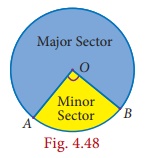
Concentric Circles
Circles with
the same centre but different radii are said to be concentric.
Here are
some real-life examples:

Congruent Circles
Two circles
are congruent if they are copies of one another or identical. That is, they have
the same size. Here are some real life examples:
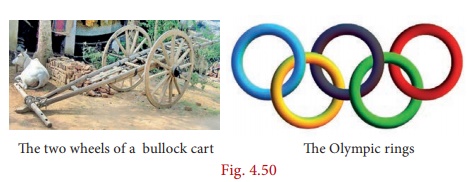
Position of a Point with respect to a Circle
Consider
a circle in a plane (Fig.4.51). Consider any point P on the circle. If the
distance from the centre O to the point P is OP, then
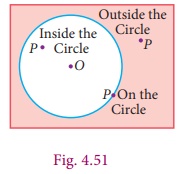
(i) OP = radius (If the point P lies
on the circle)
(ii) OP < radius (If the point P Point
lies inside the circle)
(iii) OP
> radius(If the point P lies outside the circle)
So, a circle
divides the plane on which it lies into three parts.
Progress Check
Say True or False
1. Every chord of a circle contains exactly two points of the circle.
2. All radii of a circle are of same length.
3. Every radius of a circle is a chord.
4. Every chord of a circle is a diameter.
5. Every diameter of a circle is a chord.
6. There can be any number of diameters for a circle.
7. Two diameters cannot have the same end-point.
8. A circle divides the plane into three disjoint parts.
9. A circle can be partitioned into a major arc and a minor arc.
10. The distance from the centre of a circle to the circumference
is that of a diameter
Thinking Corner
1. How many sides does a circle have ?
2. Is circle, a polygon?
Circle Through Three Points
We have already
learnt that there is one and only one line passing through two points. In the same
way, we are going to see how many circles can be drawn through a given point, and
through two given points. We see that in both cases there can be infinite number
of circles passing through a given point P (Fig.4.52) , and through two given
points A and B (Fig.4.53).
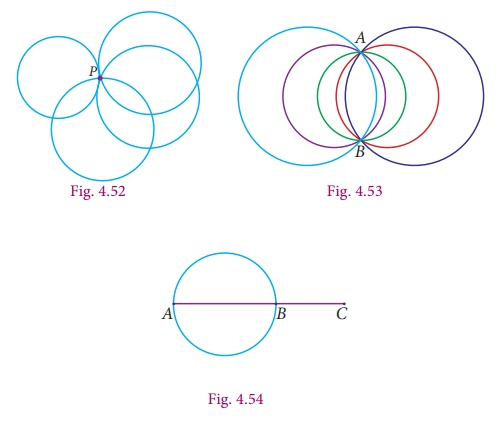
Now consider three collinear points A, B and C (Fig.4.14). Can we draw a circle passing through these three points? Think over it. If the points are collinear, we can’t?
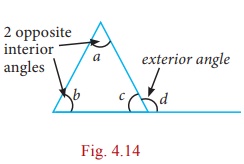
If the three
points are non collinear, they form a triangle (Fig.4.55). Recall the construction
of the circumcentre. The intersecting point of the perpendicular bisector of the
sides is the circumcentre and the circle is circumcircle.
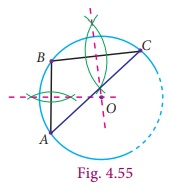
Therefore
from this we know that, there is a unique circle which passes through A,
B and C. Now, the above statement leads to a result as follows.
Theorem 6 There is one and only one circle passing through three non-collinear
points.
Related Topics